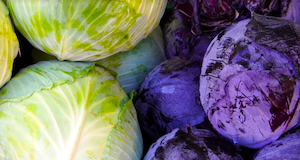Welcome to
Pro-Organic Belize
Tropical
Garden Grow Guide
Where
you are the student and the teacher.

| Botanic name | Brassica oleracea |
| Plant type | annual vegetable |
| Sun exposure | At least six hours a day full sun
is recommended |
| Soil pH | 6.5 – 7.0 is optimal and helps to discourage club root; add dolomite if your soil is too acid |
| Soil preference | Rich fertile, loose soil with compost and well rotted manure worked in |
by Mary Loan
Description: A
round headed leafy cruciferous vegetable. There are
white, green and purple varieties and several variations
of cabbage. This
grow guide will feature the three common varieties,
How to grow: Cabbage
seeds may be started in potting soil or planted directly
where they will be grown, Look for heat resistant
varieties. Seeds
will germinate in 6-10 days, plant seedlings at least
two feet apart when secondary leaves form; allow only
the first leaves to be ½ inch out of the ground. Dawn Dean,
author of Gardening in Southern Belize recommends
planting cabbage seedlings 15 inches apart and
harvesting every other cabbage as their leaves begin to
touch. They are tender and delicious. It is advised
to plant cabbage seedlings in the rainy season in Belize
for harvest in the dry season. Cabbage can take from 6
to 18 weeks to mature.
They require regular watering and benefit from
compost tea, Here
is an easy homemade recipe for DIY fertilizer: ¼ cup
epsom salts, 2 cups urine, grass and weed clippings that
have been steeped in water in a 5 gallon bucket with a
cover for at least 2 weeks. Strain the water from
clippings mix with epsom salts and urine apply as a side
fertilizer when watering plants.
Disease and insect
control: It
is a wonder how cabbage has survived as a food crop for
thousands of years. Cabbage is susceptable to cabbage
worms, small white butterflies, aphids, earwigs, club
root (a fungal disease), snails and slugs. To help
control damage it is advisable to check under the leaves
for worms and bugs and pick them off and use an organic
insecticide if things get out of control. Cabbage plants
are compatible with bush beans, celery, cucumbers,
onions, marigolds and aromatic herbs, like oregano and
thyme. Avoid
planting pole beans, tomatoes, hot peppers or eggplant
near cabbage. Do not plant cabbage in the same location
for at least three years to reduce pests and disease. .
Cabbage is susceptable
to cabbage worms, small white butterflies, aphids,
earwigs, club root (a fungal disease), snails and slugs. To help
control damage it is advisable to check under the leaves
for worms and bugs and pick them off and use an organic
insecticide if things get out of control. Cabbage plants
are compatible with bush beans, celery, cucumbers,
onions, marigolds and aromatic herbs, like oregano and
thyme. Avoid
planting pole beans, tomatoes, hot peppers or eggplant
near cabbage. Do not plant cabbage in the same location
for at least three years to reduce pests and disease.
How to harvest: Use
a large sharp knife or a machete to cut off just the
head of the cabbage when it is hard and ripe. Cabbages
have a tendency to split open when too ripe. Leave the base
in place and continue
to water as delicious leaves and little cabbages will
continue to produce from the base.
Health benefits: Cabbages
contain a storehouse of nutrition and healing
properties, including,Vitamin C, B6 and K, folic acid,
calcium, magnesium, manganese, potassium, antioxidants
and fiber.
Red cabbage is higher
in nutrients than white or green.
Recipes: Cabbage
may be shredded for raw salads, steamed, stuffed, baked,
fermented to make sauerkraut and kimchee. Here is a very
tasty easy to make cabbage recipe:
- oil a large baking
pan,
- cut a cabbage into
wedges or slices that are about 1” thick arrange wedges
in a single layer in the pan
- brush cabbage with
olive oil sprinkle with sea salt and freshly ground
pepper. Bake
for approximately 1/2 hour at 400 degrees F or until
cabbage begins to carmelize around the edges.
-
Squeeze lemon juice on top, drizzle with tahini sauce
and serve.